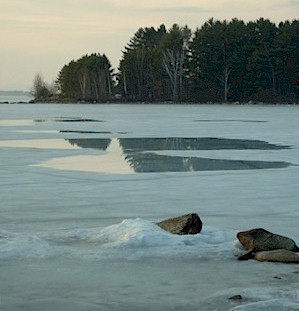Home → Land Resources → Programs → Natural Resources Protection Act
Natural Resources Protection Act (NRPA)
The Land Bureau has developed an online licensing system which is applicable for all Land Licenses except Mining and Hydropower. Access the licensing system MELS Hub.
Land Application and Permit Status
Chapters 305 and 310 rule changes webinar (YouTube): Learn about recently adopted changes to the Department’s Chapter 305 NRPA Permit by Rule Standards and Chapter 310 Wetlands and Waterbodies Protection rules pertaining to shoreline stabilization and other activities.
Protected Natural Resources
Protected natural resources are coastal sand dune systems, coastal wetlands, significant wildlife habitat, fragile mountain areas, freshwater wetlands, great ponds and rivers, streams or brooks. See 38 MRSA 480-B for statutory definitions.

The purpose section of the Natural Resources Protection Act (NRPA) provides, in part, that: "The Legislature finds and declares that the State's rivers and streams, great ponds, fragile mountain areas, freshwater wetlands, significant wildlife habitat, coastal wetlands and coastal sand dune systems are resources of state significance. These resources have great scenic beauty and unique characteristics, unsurpassed recreational, cultural, historical and environmental value of present and future benefit to the citizens of the State and that uses are causing the rapid degradation and, in some cases, the destruction of these critical resources, producing significant adverse economic and environmental impacts and threatening the health, safety and general welfare of the citizens of the State."
The law is focused on "protected natural resources". A permit is required when an "activity" will be:
- Located in, on or over any protected natural resource, or
- Located adjacent to (A) a coastal wetland, great pond, river, stream or brook or significant wildlife habitat contained within a freshwater wetland, or (B) certain freshwater wetlands.
An "activity" is (A) dredging, bulldozing, removing or displacing soil, sand, vegetation or other materials; (B) draining or otherwise dewatering; (C) filling, including adding sand or other material to a sand dune; or (D) any construction, repair or alteration of any permanent structure.
Certain exemptions apply. A pre-application meeting is required for some projects, and is available on request for others. The NRPA is administered by the DEP in organized areas.
Contacts
Have a question or need more information? Use the links below to find out more or connect with DEP staff.
Most Land Bureau inquiries can be made using one of the fillable forms above. Submitting the online form ensures that your inquiry, complaint or request for information will be viewed and responded to as soon as possible by a Bureau staff person. Because of the high volume of inquiries, it may take several days for you to receive a response or follow up.
Statutory sections
Title 38, Chapter 3, §§ 480-A to 480-Z. [note: this link is to the text at the Office of Revisor of Statutes' site. Always check the disclaimer there -- the text may not include the most recent changes.]
Rules
- Chapter 305 (Word) -- Permit by Rule
- Chapter 310 (Word) -- Wetlands
- Chapter 315 (Word) -- Assessing and Mitigating Impacts to Scenic and Aesthetic Uses
- Chapter 335 (Word) -- Significant Wildlife Habitat Rules
- Chapter 355 (Word) -- Sand Dune Systems
- Chapter 342 (Word) -- Significant Groundwater Wells
Forms
Important Note: See the Department Fee Schedule (pdf), under Land Resources - Natural Resources Protection Act, for the current fee to submit with completed applications.
- Permit by Rule information page
- Forms associated with some of the sections of Permit by Rule:
Supplemental materials
- Authority over Activities Adjacent to Protected Natural Resources (issue profile)
- Designing Projects to Minimize Impacts upon Natural Resources (fact sheet)
- Natural Resources Pre-application meetings
- Natural Resources Protection Act (NRPA) (issue profile)
- Permit-by-Rule (NRPA)
- Natural Resource Compensation: Methods for Restoring Lost Functions and Values (fact sheet)
Wildlife
- Essential wildlife habitat (Endangered Species Act) (off-site). Once an area becomes designated as Essential Habitat, no state agency or municipal government may permit, license, fund or carry out projects that would significantly alter the habitat or violate protection guidelines adopted for the habitat.
- Significant Wildlife Habitat: Bird Habitats
- Increased Protection of Significant Wildlife Habitats: High and Moderate Value Waterfowl & Wading Bird Habit and Shorebird Nesting, Feeding and Staging Areas (fact sheet)
- Significant Wildlife Habitat: Significant Vernal Pools
- Vernal Pools: A Significant Wildlife Habitat (fact sheet)
Wetlands
- In Lieu Fee Compensation Program and Maine Natural Resource Conservation Program (ILFP and MNRCP)
- In Lieu Fee Fact Sheet(pdf)
- Maine's Wetlands -- Their Functions and Values (issue profile)
- Wetlands Compensation -- Techniques for Restoring Lost Functions and Values (issue profile)
- Wetlands Protection -- A Federal, State and Local Partnership (issue profile)
- Wetlands and Waterbodies Protection Rules (issue profile)
- Guidance for Evaluating Wetland Conversion Impacts (pdf)
Other Resources
- Agricultural Irrigation Ponds (issue profile)
- Applications to Dredge or to Dispose of Dredged Material in Coastal Waters (issue profile)
- Cranberry Cultivation Projects (fact sheet)
- Sand Dune Activities FAQ (pdf)
- Sand Dune and Storm Repair FAQ (pdf)
- Significant groundwater wells
- Stream Identification Guide (pdf)
National Wetland Inventory Maps
Important Disclaimer: National Wetland Inventory (NWI) maps are produced by the U.S. Fish and Wildlife Service from interpretation of aerial photographs. They provide approximate information on the types, extent, and locations of wetland resources and are used for a variety of purposes. The accuracy of the NWI wetland information, especially wetland sizes and locations, can be a factor of the time of year when photographs were taken, the density of tree canopies, and other obstacles to photo-interpretation. They therefore should not be used as the sole source of information when accurate wetland information is critical. NWI maps do not substitute for site specific field investigations and wetland boundary delineations required by the Department pursuant to the Natural Resources Protection Act (38 M.R.S.A. §§480-A et seq.) and the Maine Wetland Protection Rules (Chapter 310). Go here to "Wetlands Digital Data" (off-site).